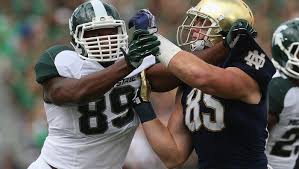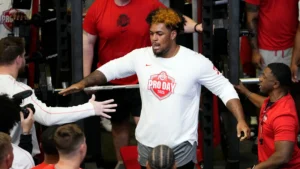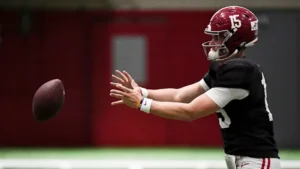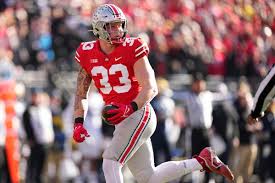
The Notre Dame football tight end heritage that keeps their NFL Draft streak alive
The University of Notre Dame, one of the most storied programs in college football, has produced a remarkable tradition of talent that stretches across positions, from quarterbacks to linemen, and defensive stalwarts to skill players. However, one of the most underappreciated, yet consistently productive, positions has been that of the tight end. Over the years, Notre Dame has not only crafted a reputation for producing elite tight ends but has also maintained a streak of sending tight ends to the NFL Draft. This legacy, built upon a rich history of great players, coaching, and development, continues to influence both the college football landscape and the NFL.
From the early days of Notre Dame football, the tight end position has held a crucial place within the team’s offensive philosophy. But it’s not just about filling the role—Notre Dame has consistently developed some of the most skilled, versatile, and durable tight ends in college football, all of whom have transitioned into successful professional careers. The key to this success lies in a combination of factors: the program’s storied history, a reputation for excellence, and a particular coaching philosophy that has evolved with the game.
Early Beginnings: Notre Dame’s Tight End Evolution
The early development of tight ends at Notre Dame can be traced back to the 1920s and 1930s, when the program began to build its reputation as a powerhouse. However, it wasn’t until the late 20th century that the tight end position began to take shape as one of the most integral spots on the field, particularly in relation to the NFL Draft.
In the 1980s, under head coach Gerry Faust and later Lou Holtz, Notre Dame began to place more emphasis on the tight end position as a hybrid between an offensive lineman and a receiver. This evolution coincided with a growing demand for players who could contribute in both the passing game and the running game—key traits that would define Notre Dame’s tight ends for decades to come. The tight end, in this era, would be a weapon capable of both blocking in the running game and providing mismatches in the passing game. This duality is what made Notre Dame’s tight ends valuable commodities at the professional level.
The Holtz Era and the Birth of the NFL Draft Streak
The true foundation for Notre Dame’s tight end heritage can be traced to the late 1980s and early 1990s when Lou Holtz’s coaching began to shape the program into a dominant national force. During this period, tight ends such as **Darryl Dewalt** (1985-1989) and **Ricky Watters** (who also played running back) began to show the potential for the position to evolve into a key part of the team’s offensive scheme.
In particular, **Irving Fryar**, a multi-sport athlete who played both wide receiver and tight end, caught the attention of NFL scouts during his time at Notre Dame. While Fryar’s success as a pass-catcher didn’t materialize fully at Notre Dame, his raw athleticism and potential as a tight end were noticed, laying the groundwork for future tight ends to build on the program’s reputation.
However, it was under Holtz’s tutelage that tight ends began to show up in greater numbers in the NFL Draft. Players like **Bennett Jackson** and **Darren Waller**, both successful NFL tight ends, set the tone for what would eventually become a yearly tradition of sending tight ends to the NFL.
The Rise of Elite Tight Ends in the 2000s
While Notre Dame had already established a strong tradition of tight ends making it to the NFL, the 2000s marked a period where this heritage truly began to crystallize into a series of elite prospects. Players like **Anthony Fasano**, who played for Notre Dame from 2002 to 2005, were crucial in solidifying the program’s place as an NFL tight end factory.
Fasano’s journey from Notre Dame to the NFL highlighted what would become a staple of the tight end position at Notre Dame—versatility. At Notre Dame, Fasano was used as both a blocker in the running game and a reliable pass-catcher in the short and intermediate passing game. His physicality and athleticism allowed him to be a constant threat on the field, whether he was lined up as a traditional tight end or in the slot. Fasano was selected in the second round of the 2006 NFL Draft by the Miami Dolphins, marking the beginning of an extended streak of Notre Dame tight ends making their way to the NFL.
Fasano was far from an isolated example. Throughout the 2000s, Notre Dame continued to produce tight ends who would go on to have successful NFL careers. **John Carlson** (2004-2007), a standout tight end at Notre Dame, also joined the ranks of successful NFL tight ends. Carlson’s athleticism and sharp route-running abilities made him an ideal candidate for the NFL, and he was selected by the Seattle Seahawks in the second round of the 2008 NFL Draft.
The combination of offensive prowess and the ability to block made these players highly valued by NFL scouts. But it wasn’t just the physical tools that set Notre Dame’s tight ends apart—it was the coaching and developmental system they underwent during their time at Notre Dame that truly prepared them for the NFL.
The Role of Coaching: Building NFL-Ready Tight Ends
One of the key components of Notre Dame’s tight end tradition is the coaching that these players receive during their time in South Bend. Whether it’s from the offensive coordinator, position coach, or the head coach himself, Notre Dame has consistently placed an emphasis on developing players to meet the challenges of the professional game.
Under coaches like **Charlie Weis** and **Brian Kelly**, the tight end position at Notre Dame was treated as a crucial role in the offensive scheme. These coaches understood that in the modern NFL, tight ends needed to be multifaceted: capable of running precise routes, blocking on the edge, and lining up in various formations. The tight end needed to be both an offensive weapon and a reliable blocker—a tall order that Notre Dame’s coaching staff was more than prepared to handle.
Additionally, Notre Dame’s offensive scheme—especially during the Weis and Kelly eras—took full advantage of the tight end’s potential as a receiver. The development of tight ends within these schemes helped players like **Tyler Eifert** (2010-2012) become first-round draft picks. Eifert, one of the most successful tight ends in recent Notre Dame history, was a matchup nightmare for defenses thanks to his combination of size, speed, and excellent hands. He was selected by the Cincinnati Bengals with the 21st overall pick in the 2013 NFL Draft, cementing Notre Dame’s tight end legacy as one of the premier pipelines to the NFL.
Maintaining the Streak: Continued Success in the NFL Draft
As the 2010s unfolded, Notre Dame’s tight end factory remained alive and well. The program continued to churn out talent year after year, ensuring the streak of sending tight ends to the NFL Draft would persist. Notable names during this period include **Ben Koyack** (2011-2014), who played an important role on the 2012 national championship runner-up team, and **Durham Smythe** (2014-2017), both of whom were selected by NFL teams.
Durham Smythe, in particular, exemplified the traits that Notre Dame tight ends have consistently showcased over the years—blocking ability, intelligence, and proficiency as a short-to-intermediate route runner. Drafted by the Miami Dolphins in the fourth round of the 2018 NFL Draft, Smythe’s skill set continued the tradition of sending well-rounded, NFL-ready tight ends to the league.
Most recently, **Cole Kmet** (2017-2019), a highly touted prospect, continued this legacy. A consensus top tight end, Kmet was drafted in the second round of the 2020 NFL Draft by the Chicago Bears. Kmet’s combination of size, hands, and route-running precision made him an appealing target in the NFL, and his selection kept Notre Dame’s tight end streak alive.
The Legacy of Notre Dame Tight Ends
The legacy of Notre Dame tight ends is more than just a list of players who made it to the NFL—it is a reflection of the program’s ability to identify, develop, and elevate talent at a position that requires a unique combination of skills. From the early days to the present, Notre Dame’s tight ends have consistently represented the program’s commitment to excellence in football. Whether it’s been through strong coaching, a dedication to versatility, or a development system tailored for NFL success, Notre Dame has built a tradition of producing tight ends who are ready to thrive at the next level.
As long as the tradition of tight end excellence continues in South Bend, Notre Dame will remain a consistent force in shaping the future of professional football. And with the NFL Draft streak alive and well, the Notre Dame tight end legacy is sure to endure for generations to come.





